Assessing the Importance of Tree Cover Threshold for Forest Cover Mapping Derived from Global Forest Cover in Myanmar
Abstract
:1. Introduction
2. Materials and Methods
2.1. Study Area
2.2. Global Forest Change Dataset
2.3. Methodology
2.3.1. Determination of Sample Points
2.3.2. Reference Data Collection
2.3.3. Accuracy Assessment
3. Results
3.1. Forest Cover Area Estimation
3.2. Accuracy Assessment
3.2.1. Ecological Zones
3.2.2. National Scale
4. Discussion
5. Conclusions
Supplementary Materials
Author Contributions
Funding
Acknowledgments
Conflicts of Interest
References
- Keenan, R.J.; Reams, G.A.; Achard, F.; de Freitas, J.V.; Grainger, A.; Lindquist, E. Dynamics of global forest area: Results from the FAO Global Forest Resources Assessment 2015. For. Ecol. Manag. 2015, 352, 9–20. [Google Scholar] [CrossRef]
- Baccini, A.; Walker, W.; Carvalho, L.; Farina, M.; Sulla-Menashe, D.; Houghton, R.A. Tropical forests are a net carbon source based on aboveground measurements of gain and loss. Science 2017, 358, 230–234. [Google Scholar] [CrossRef] [PubMed]
- Houghton, R. Carbon emissions and the drivers of deforestation and forest degradation in the tropics. Curr. Opin. Environ. Sustain. 2012, 4, 597–603. [Google Scholar] [CrossRef]
- Brooks, T.M.; Mittermeier, R.A.; Mittermeier, C.G.; da Fonseca, G.A.B.; Rylands, A.B.; Konstant, W.R.; Flick, P.; Pilgrim, J.; Oldfield, S.; Magin, G.; et al. Habitat Loss and Extinction in the Hotspots of Biodiversity. Conserv. Biol. 2002, 16, 909–923. [Google Scholar] [CrossRef]
- Giam, X. Global biodiversity loss from tropical deforestation. Proc. Natl. Acad. Sci. USA 2017, 114, 5775–5777. [Google Scholar] [CrossRef] [PubMed]
- Hughes, A.C. Understanding the drivers of Southeast Asian biodiversity loss. Ecosphere 2017, 8, e01624. [Google Scholar] [CrossRef]
- Gómez, C.; White, J.C.; Wulder, M.A. Optical remotely sensed time series data for land cover classification: A review. ISPRS J. Photogramm. Remote Sens. 2016, 116, 55–72. [Google Scholar] [CrossRef]
- Wulder, M.A.; White, J.C.; Goward, S.N.; Masek, J.G.; Irons, J.R.; Herold, M.; Cohen, W.B.; Loveland, T.R.; Woodcock, C.E. Landsat continuity: Issues and opportunities for land cover monitoring. Remote Sens. Environ. 2008, 112, 955–969. [Google Scholar] [CrossRef]
- Turner, W.; Rondinini, C.; Pettorelli, N.; Mora, B.; Leidner, A.K.; Szantoi, Z.; Buchanan, G.; Dech, S.; Dwyer, J.; Herold, M.; et al. Free and open-access satellite data are key to biodiversity conservation. Biol. Conserv. 2015, 182, 173–176. [Google Scholar] [CrossRef]
- Hansen, M.C.; Potapov, P.V.; Moore, R.; Hancher, M.; Turubanova, S.A.; Tyukavina, A.; Thau, D.; Stehman, S.V.; Goetz, S.J.; Loveland, T.R.; et al. High-Resolution Global Maps of 21st-Century Forest Cover Change. Science 2013, 342, 850–853. [Google Scholar] [CrossRef]
- Oldekop, J.A.; Sims, K.R.E.; Karna, B.K.; Whittingham, M.J.; Agrawal, A. Reductions in deforestation and poverty from decentralized forest management in Nepal. Nat. Sustain. 2019, 2, 421–428. [Google Scholar] [CrossRef]
- Pelletier, J.; Gélinas, N.; Potvin, C. Indigenous perspective to inform rights-based conservation in a protected area of Panama. Land Use Policy 2019, 83, 297–307. [Google Scholar] [CrossRef]
- Santika, T.; Meijaard, E.; Budiharta, S.; Law, E.A.; Kusworo, A.; Hutabarat, J.A.; Indrawan, T.P.; Struebig, M.; Raharjo, S.; Huda, I.; et al. Community forest management in Indonesia: Avoided deforestation in the context of anthropogenic and climate complexities. Glob. Environ. Chang. 2017, 46, 60–71. [Google Scholar] [CrossRef]
- Davis, K.F.; Yu, K.; Rulli, M.C.; Pichdara, L.; D’Odorico, P. Accelerated deforestation driven by large-scale land acquisitions in Cambodia. Nat. Geosci. 2015, 8, 772–775. [Google Scholar] [CrossRef]
- Lonn, P.; Mizoue, N.; Ota, T.; Kajisa, T.; Yoshida, S. Biophysical Factors Affecting Forest Cover Changes in Community Forestry: A Country Scale Analysis in Cambodia. Forests 2018, 9, 273. [Google Scholar] [CrossRef]
- Lonn, P.; Mizoue, N.; Ota, T.; Kajisa, T.; Yoshida, S. Using Forest Cover Maps and Local People’s Perceptions to Evaluate the Effectiveness of Community-based Ecotourism for Forest Conservation in Chambok (Cambodia). Environ. Conserv. 2019, 46, 111–117. [Google Scholar] [CrossRef]
- Potapov, P.; Hansen, M.C.; Laestadius, L.; Turubanova, S.; Yaroshenko, A.; Thies, C.; Smith, W.; Zhuravleva, I.; Komarova, A.; Minnemeyer, S.; et al. The last frontiers of wilderness: Tracking loss of intact forest landscapes from 2000 to 2013. Sci. Adv. 2017, 3, e1600821. [Google Scholar] [CrossRef]
- Sannier, C.; McRoberts, R.E.; Fichet, L. Suitability of Global Forest Change data to report forest cover estimates at national level in Gabon. Remote Sens. Environ. 2016, 173, 326–338. [Google Scholar] [CrossRef]
- Yang, Z.; Dong, J.; Liu, J.; Zhai, J.; Kuang, W.; Zhao, G.; Shen, W.; Zhou, Y.; Qin, Y.; Xiao, X. Accuracy Assessment and Inter-Comparison of Eight Medium Resolution Forest Products on the Loess Plateau, China. ISPRS Int. J. Geo Inf. 2017, 6, 152. [Google Scholar] [CrossRef]
- Lui, G.V.; Coomes, D.A. A comparison of novel optical remote sensing-based technologies for forest-cover/change monitoring. Remote Sens. 2015, 7, 2781–2807. [Google Scholar] [CrossRef]
- McRoberts, R.E.; Vibrans, A.C.; Sannier, C.; Næsset, E.; Hansen, M.C.; Walters, B.F.; Lingner, D.V. Methods for evaluating the utilities of local and global maps for increasing the precision of estimates of subtropical forest area. Can. J. For. Res. 2016, 46, 924–932. [Google Scholar] [CrossRef]
- Arjasakusuma, S.; Kamal, M.; Hafizt, M.; Forestriko, H.F. Local-scale accuracy assessment of vegetation cover change maps derived from Global Forest Change data, ClasLite, and supervised classifications : Case study at part of Riau Province, Indonesia. Appl. Geomat. 2018, 10, 205–217. [Google Scholar] [CrossRef]
- Burivalova, Z.; Bauert, M.R.; Hassold, S.; Fatroandrianjafinonjasolomiovazo, N.T.; Koh, L.P. Relevance of Global Forest Change Data Set to Local Conservation : Case Study of Forest Degradation in Masoala National Park, Madagascar. Biotropica 2015, 47, 267–274. [Google Scholar] [CrossRef]
- Linke, J.; Fortin, M.; Courtenay, S.; Cormier, R. High-resolution global maps of 21st-century annual forest loss: Independent accuracy assessment and application in a temperate forest region of Atlantic Canada. Remote Sens. Environ. 2017, 188, 164–176. [Google Scholar] [CrossRef]
- Mitchard, E.; Viergever, K.; Morel, V.; Tipper, R. Assessment of the Accuracy of University of Maryland (Hansen et al.) Forest Loss Data in 2 ICF Project Areas—Component of a Project that Tested an ICF Indicator Methodology, 2015.
- Food and Agriculture Organization (FAO). Global Forest Resources Assessment 2015: How Are the World’s Forests Changing? 2nd ed.; FAO: Rome, Italy, 2016; ISBN 9789251092835. [Google Scholar]
- Food and Agriculture Organization (FAO). Global Forest Resource Assessment 2015 Country Report: Myanmar; FAO: Rome, Italy, 2014. [Google Scholar]
- Food and Agriculture Organization (FAO). Global Ecological Zones for FAO Forest Reporting: 2010 Update; FAO: Rome, Italy, 2012. [Google Scholar]
- Simons, H. FRA 2000.Global Ecological Zoning for the Global Forest Resources Assessment 2000: Final Report; FAO: Rome, Italy, 2001. [Google Scholar]
- GADM. Available online: https://gadm.org/download_world.html (accessed on 3 November 2017).
- Global Forest Change. Available online: https://earthenginepartners.appspot.com/science-2013-global-forest/download_v1.2.html (accessed on 3 November 2017).
- Global Ecological Zone. Available online: http://193.43.36.20/map?entryId=baa463d0-88fd-11da-a88f-000d939bc5d8 (accessed on 29 May 2018).
- Olofsson, P.; Foody, G.M.; Herold, M.; Stehman, S.V.; Woodcock, C.E.; Wulder, M.A. Good practices for estimating area and assessing accuracy of land change. Remote Sens. Environ. 2014, 148, 42–57. [Google Scholar] [CrossRef]
- Sepal Platform. Available online: https://sepal.io/ (accessed on 15 August 2018).
- Food and Agriculture Organization (FAO). Map Accuracy Assessment and Area Estimation: A Practical Guide; FAO: Rome, Italy, 2016. [Google Scholar]
- Venkatappa, M.; Sasaki, N.; Shrestha, R.P.; Tripathi, N.K.; Ma, H.O. Determination of vegetation thresholds for assessing land use and land use changes in Cambodia using the Google Earth Engine cloud-computing platform. Remote Sens. 2019, 11, 1514. [Google Scholar] [CrossRef]
- Tilahun, A.; Teferie, B. Accuracy Assessment of Land Use Land Cover Classification using Google Earth. Am. J. Environ. Prot. 2015, 4, 193. [Google Scholar] [CrossRef]
- Rwanga, S.S.; Ndambuki, J.M. Accuracy Assessment of Land Use/Land Cover Classification Using Remote Sensing and GIS. Int. J. Geosci. 2017, 8, 611–622. [Google Scholar] [CrossRef]
- Brun, C.; Cook, A.R.; Lee, J.S.H.; Wich, S.A.; Koh, L.P.; Carrasco, L.R. Analysis of deforestation and protected area effectiveness in Indonesia: A comparison of Bayesian spatial models. Glob. Environ. Chang. 2015, 31, 285–295. [Google Scholar] [CrossRef]
- Yang, Y.; Xiao, P.; Feng, X.; Li, H. Accuracy assessment of seven global land cover datasets over China. ISPRS J. Photogramm. Remote Sens. 2017, 125, 156–173. [Google Scholar] [CrossRef]
- Dhar, R.B.; Chakraborty, S.; Chattopadhyay, R.; Sikdar, P.K. Impact of Land-Use/Land-Cover Change on Land Surface Temperature Using Satellite Data: A Case Study of Rajarhat Block, North 24-Parganas District, West Bengal. J. Indian Soc. Remote Sens. 2019, 47, 331–348. [Google Scholar] [CrossRef]
- Yang, R.; Luo, Y.; Yang, K.; Hong, L.; Zhou, X. Analysis of forest deforestation and its driving factors in Myanmar from 1988 to 2017. Sustainability 2019, 11, 3047. [Google Scholar] [CrossRef] [Green Version]
- Potere, D. Horizontal Positional Accuracy of Google Earth’s High-Resolution Imagery Archive. Sensors 2008, 8, 7973–7981. [Google Scholar] [CrossRef] [PubMed]
- Mahdianpari, M.; Salehi, B.; Mohammadimanesh, F.; Homayouni, S.; Gill, E. The first wetland inventory map of newfoundland at a spatial resolution of 10 m using sentinel-1 and sentinel-2 data on the Google Earth Engine cloud computing platform. Remote Sens. 2019, 11, 43. [Google Scholar] [CrossRef] [Green Version]
- Poortinga, A.; Tenneson, K.; Shapiro, A.; Nquyen, Q.; Aung, K.S.; Chishtie, F.; Saah, D. Mapping plantations in Myanmar by fusing Landsat-8, Sentinel-2 and Sentinel-1 data along with systematic error quantification. Remote Sens. 2019, 11, 831. [Google Scholar] [CrossRef] [Green Version]
- Bey, A.; Sanchez-Paus, A.; Pekkarinen, A.; Patriarca, C.; Maniatis, D.; Weil, D.; Mollicone, D.; Marchi, G.; Niskala, J.; Rezende, M.; et al. Open Foris: Collect Earth 1.1.1 User Manual; FAO: Rome, Italy, 2015. [Google Scholar]
- Bey, A.; Díaz, A.S.P.; Maniatis, D.; Marchi, G.; Mollicone, D.; Ricci, S.; Bastin, J.F.; Moore, R.; Federici, S.; Rezende, M.; et al. Collect earth: Land use and land cover assessment through augmented visual interpretation. Remote Sens. 2016, 8, 807. [Google Scholar] [CrossRef] [Green Version]
- Bastin, J.F.; Berrahmouni, N.; Grainger, A.; Maniatis, D.; Mollicone, D.; Moore, R.; Patriarea, C.; Picard, N.; Sparrow, B.; Abraham, E.M.; et al. The extent of forest in dryland biomes. Science 2017, 356, 635–638. [Google Scholar] [CrossRef] [Green Version]
- Mitri, G.; Nasrallah, G.; Gebrael, K.; Bou Nassar, M.; Abou Dagher, M.; Nader, M.; Masri, N.; Choueiter, D. Assessing land degradation and identifying potential sustainable land management practices at the subnational level in Lebanon. Environ. Monit. Assess. 2019, 191, 567. [Google Scholar] [CrossRef]
- Leite, A.; Cáceres, A.; Melo, M.; Mills, M.S.L.; Monteiro, A.T. Reducing emissions from Deforestation and forest Degradation in Angola: Insights from the scarp forest conservation ‘hotspot’. Land Degrad. Dev. 2018, 29, 4291–4300. [Google Scholar] [CrossRef]
- Vega Isuhuaylas, L.A.; Hirata, Y.; Santos, L.C.V.; Torobeo, N.S. Natural forest mapping in the Andes (Peru): A comparison of the performance of machine-learning algorithms. Remote Sens. 2018, 10, 782. [Google Scholar] [CrossRef] [Green Version]
- De Alban, J.D.T.; Prescott, G.W.; Woods, K.M.; Jamaludin, J.; Latt, K.T.; Lim, C.L.; Maung, A.C.; Webb, E.L. Integrating analytical frameworks to investigate land-cover regime shifts in dynamic landscapes. Sustainability 2019, 11, 1139. [Google Scholar] [CrossRef] [Green Version]
- Muro, J.; Strauch, A.; Heinemann, S.; Steinbach, S.; Thonfeld, F.; Waske, B.; Diekkrüger, B. Land surface temperature trends as indicator of land use changes in wetlands. Int. J. Appl. Earth Obs. Geoinf. 2018, 70, 62–71. [Google Scholar] [CrossRef]
- Pelletier, J.; Chidumayo, E.; Trainor, A.; Siampale, A.; Mbindo, K. Distribution of tree species with high economic and livelihood value for Zambia. For. Ecol. Manag. 2019, 441, 280–292. [Google Scholar] [CrossRef]
- Messina, M.; Cunliffe, R.; Farcomeni, A.; Malatesta, L.; Smit, I.P.J.; Testolin, R.; Ribeiro, N.S.; Nhancale, B.; Vitale, M.; Attorre, F. An innovative approach to disentangling the effect of management and environment on tree cover and density of protected areas in African savanna. For. Ecol. Manag. 2018, 419–420, 1–9. [Google Scholar] [CrossRef]
- Asrat, Z.; Taddese, H.; Ørka, H.O.; Gobakken, T.; Burud, I.; Næsset, E. Estimation of forest area and canopy cover based on visual interpretation of satellite images in Ethiopia. Land 2018, 7, 92. [Google Scholar] [CrossRef] [Green Version]
- Food and Agriculture Organization (FAO). Forest Resoruce Assessment 2015 Terms and Definition; FAO: Rome, Italy, 2012. [Google Scholar]
- Foody, G.M. Thematic map comparison: Evaluating the statistical significance of differences in classification accuracy. Photogramm. Eng. Remote Sens. 2004, 70, 627–633. [Google Scholar] [CrossRef]
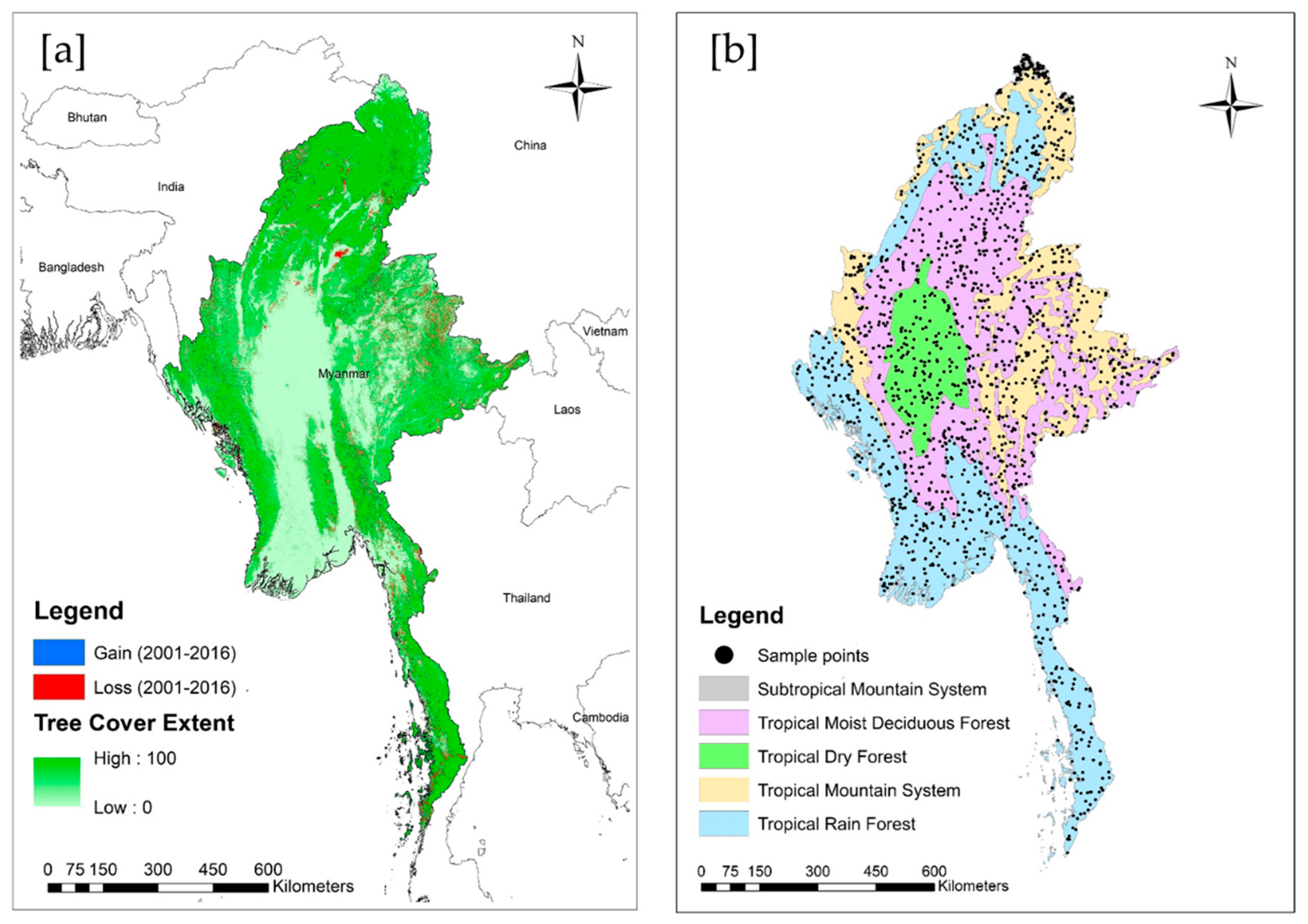
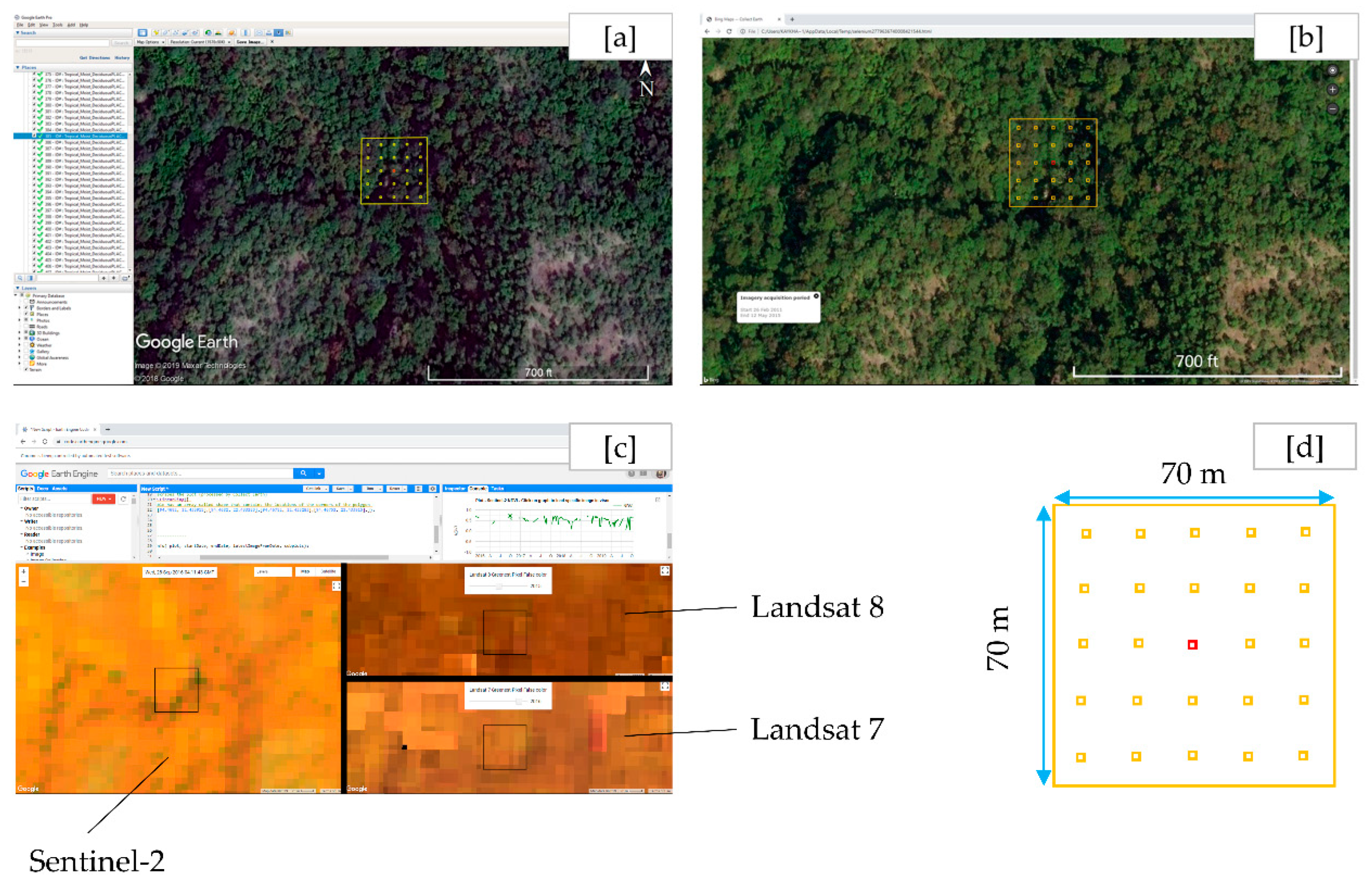


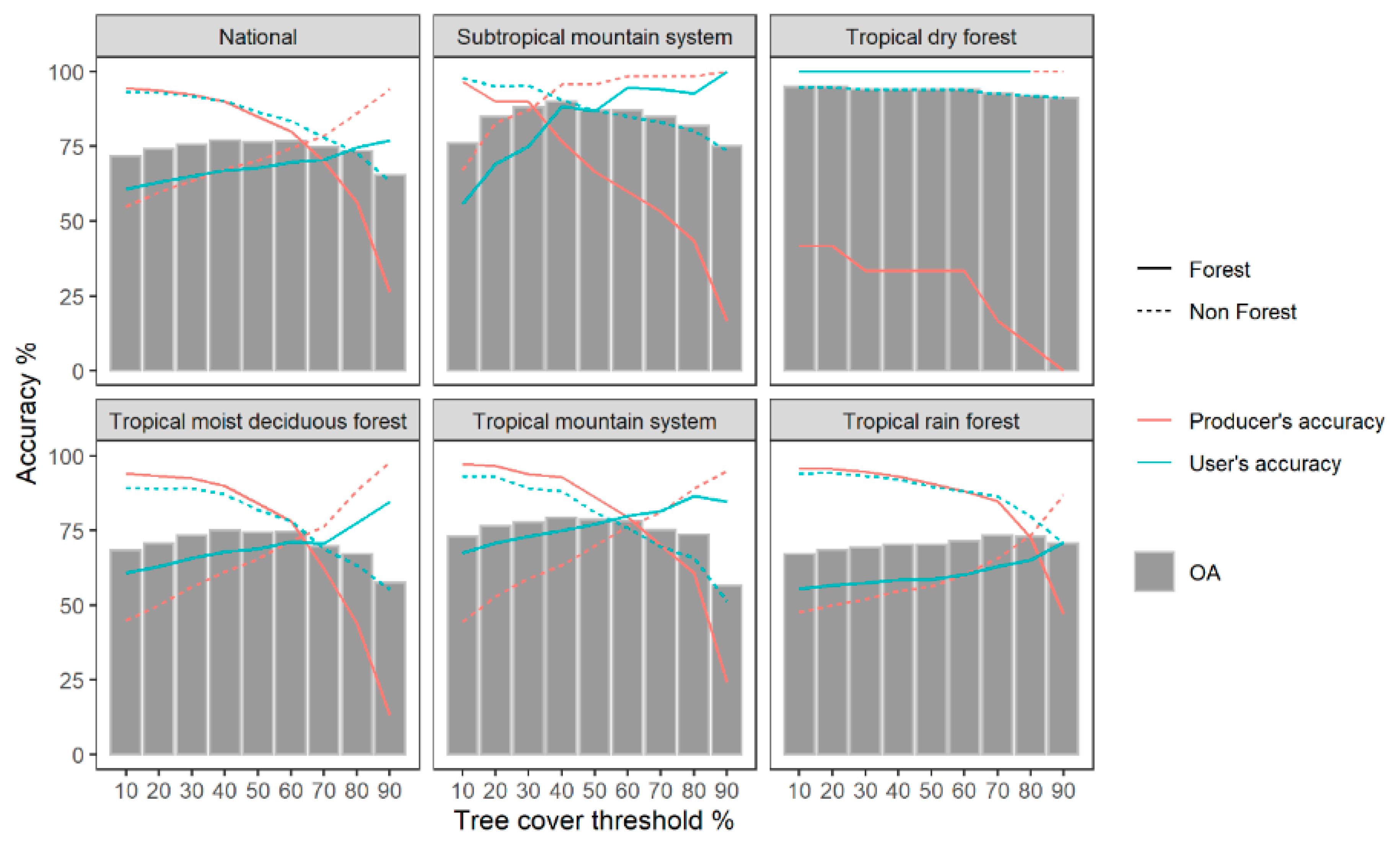
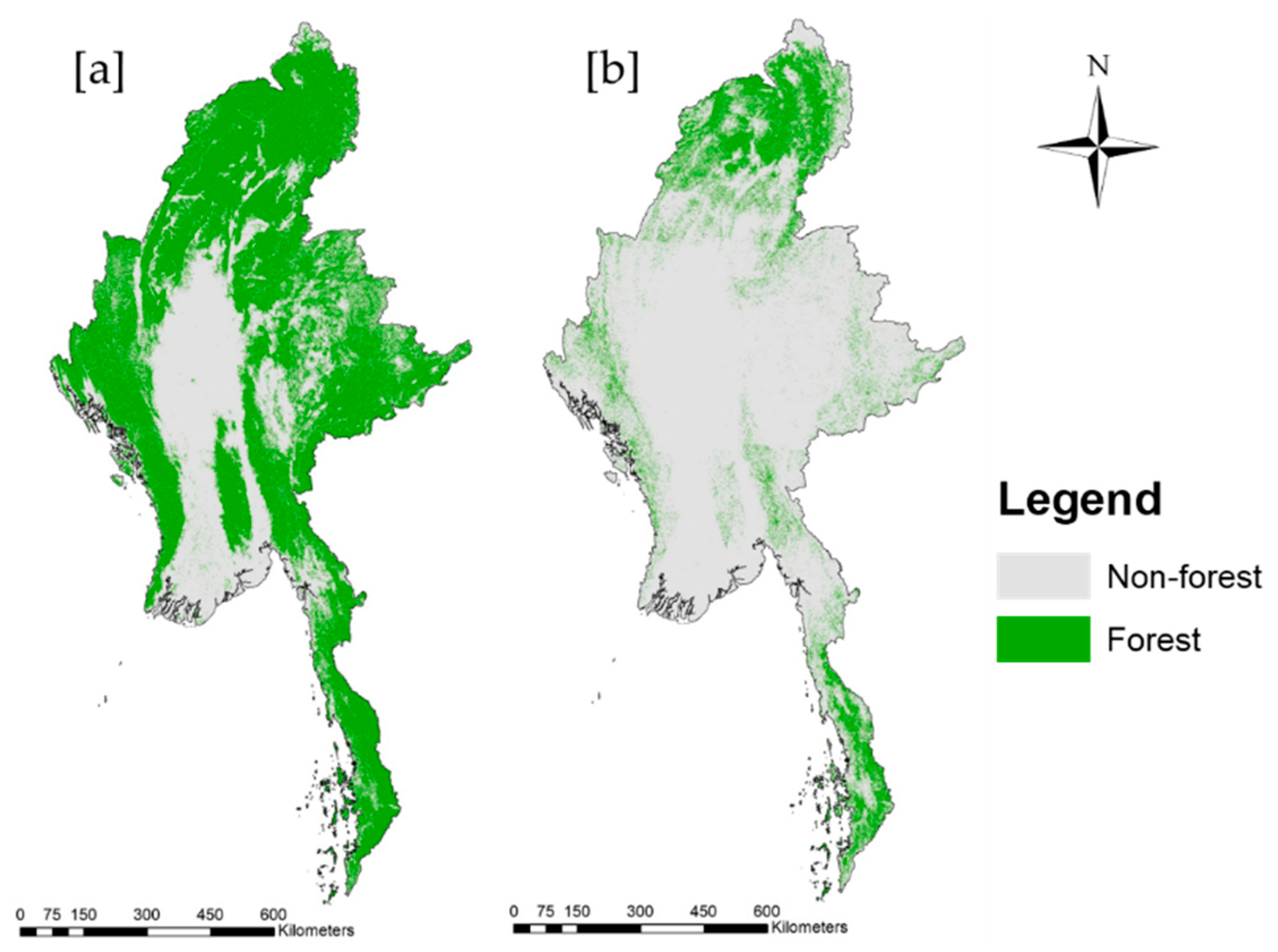
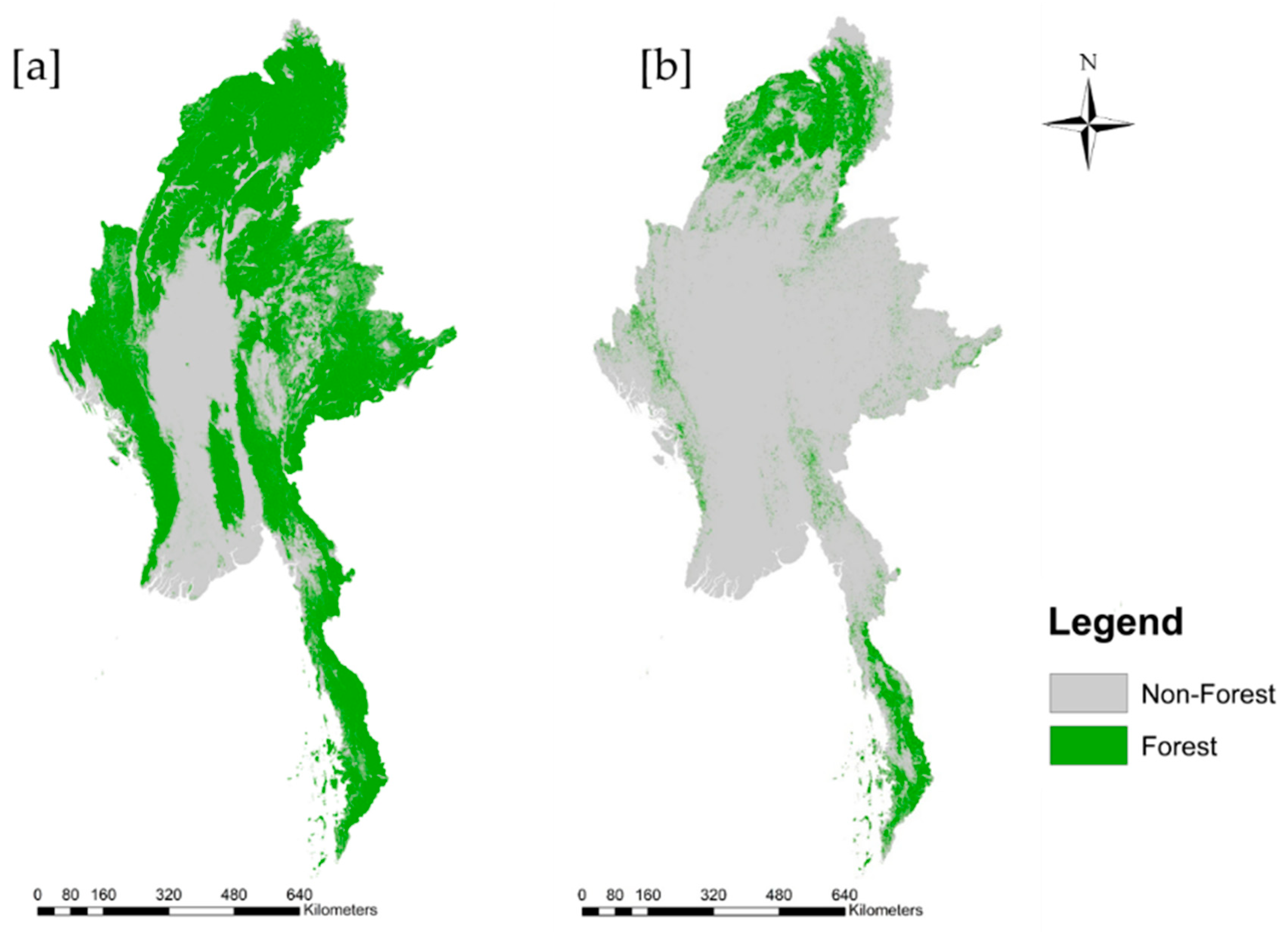
| Ecological Zones | Area (1000 ha) | Sample Points |
|---|---|---|
| Subtropical Mountain System | 412 | 100 |
| Tropical Dry Forest | 5998 | 137 |
| Tropical Moist Deciduous Forest | 23,080 | 527 |
| Tropical Mountain System | 14,550 | 334 |
| Tropical Rainforest | 22,670 | 502 |
| Total | 66,710 | 1600 |
© 2019 by the authors. Licensee MDPI, Basel, Switzerland. This article is an open access article distributed under the terms and conditions of the Creative Commons Attribution (CC BY) license (http://creativecommons.org/licenses/by/4.0/).
Share and Cite
Lwin, K.K.; Ota, T.; Shimizu, K.; Mizoue, N. Assessing the Importance of Tree Cover Threshold for Forest Cover Mapping Derived from Global Forest Cover in Myanmar. Forests 2019, 10, 1062. https://doi.org/10.3390/f10121062
Lwin KK, Ota T, Shimizu K, Mizoue N. Assessing the Importance of Tree Cover Threshold for Forest Cover Mapping Derived from Global Forest Cover in Myanmar. Forests. 2019; 10(12):1062. https://doi.org/10.3390/f10121062
Chicago/Turabian StyleLwin, Kay Khaing, Tetsuji Ota, Katsuto Shimizu, and Nobuya Mizoue. 2019. "Assessing the Importance of Tree Cover Threshold for Forest Cover Mapping Derived from Global Forest Cover in Myanmar" Forests 10, no. 12: 1062. https://doi.org/10.3390/f10121062
APA StyleLwin, K. K., Ota, T., Shimizu, K., & Mizoue, N. (2019). Assessing the Importance of Tree Cover Threshold for Forest Cover Mapping Derived from Global Forest Cover in Myanmar. Forests, 10(12), 1062. https://doi.org/10.3390/f10121062





